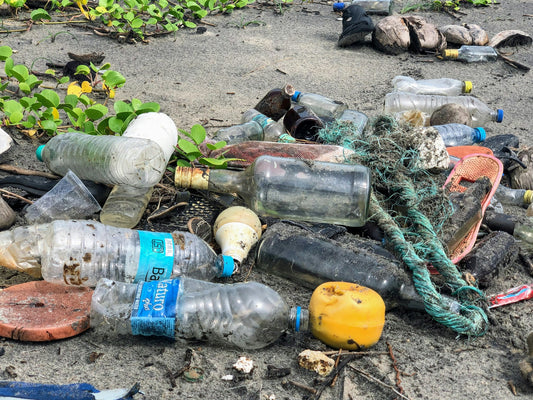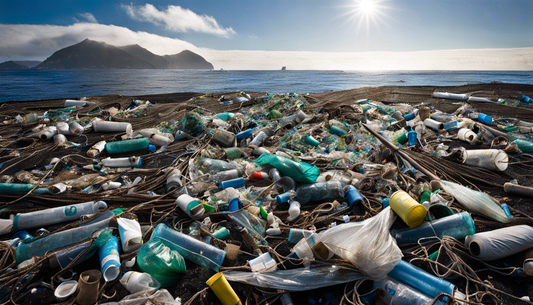Share
In our modern world, where global climate change has become a significant problem and pollution is suffocating our planet.
There is no doubt that waste is having a negative effect on the environment, from the landfills that are filling up to the rivers and seas that are becoming increasingly polluted.
The effects of these issues are not limited to the individual and the environment but extend to the generations that are yet to inherit this world.
Therefore, it is every person's duty to ensure that the environment is protected and conserved during this crucial period.
Among the many activities that we can do to reduce waste, composting is among the most straightforward and impactful.
And more importantly: It can be a lot of fun!
--------------------------
Quick heads-up: This article contains affiliate links. In some cases we recommend partner products that we are convinced of, rather than distributing the products ourselves. If you click these links and buy something, we may earn a small commission, while you can save money. Call that a win-win-win 😊.
Composting: The Environmental Game Changer
Composting is the act of reusing organic waste materials and converting them into useful soil fertilizer, greatly minimizing the amount of waste dumped into landfills.
Composting has been around for centuries; even the early societies understood the need to break down organic materials to put them back into the soil.
In the modern world, where concern for the environment is growing, composting has resurfaced as an effective and feasible method of preventing pollution.
The EPA states that food waste and yard waste make up over 28% of what we discard and can be composted.
This way, those who are involved in waste management will have an opportunity to lessen methane emissions from landfills and carbon emissions from incineration, which are both potent greenhouse gases.
A study even found that If every American composted, it could be equivalent to removing 7.8 million cars from the road.
Besides reducing climate change impacts, composting enhances soil fertility by improving its water retention capacity and reducing diseases and pests.
Composting can also increase the soil's capability to retain water, as compost can hold up to five times its weight in water.
Why You Should Build a DIY Compostable Container?
Making your own compostable container is not only environmentally friendly but is also an interesting activity that you can try doing at home.
It enables you to use materials that you most probably have at home, hence minimizing the cost and the need of new materials.
Moreover, a homemade compost bin can be built to match the size and shape of your kitchen and be completely integrated into your kitchen routine.
Materials You Will Need
- Container with Lid: A large vessel or container that is covered. This could be an old plastic bin, a metal bucket, or even a wooden box that had been used to store vegetables, fruits, grains, etc.
- Second Container Without Lid: A container to place your compost in that keeps draining water. Ideally it has a similar size as the first container. You could for example take two buckets of similar size.
- Drill: To drill aeration holes that ensure air circulation in your DIY compost.
- Charcoal Filter: To filter the smell that is usually associated with the accumulation of waste materials.
-
Newspaper or Cardboard: This will be the bottom layer, breaking down with the kitchen scraps.
- Kitchen Scraps: Orange skin, carrot tops, banana skins, tea leaves, etc.
- Garden Waste: Leaves, small twigs, grass clippings, etc.
- Water: To maintain the required level of moisture in the compost.
- Compost Starter: Optional but can help speed up the process.
Steps You Need to Follow
By now, you're either all fired up and ready to build your DIY compost, or we already intimidated you with the material list.
Don't worry, the build is relatively straight forward and if you ever assembled an ikea item, you wont have a problem building the compost.
If you want to go the easy route though and just buy a compost, check out Lomi, who offer a smart kitchen composter that gives you perfect soil for your garden over night.

Just click the button, wait a few hours for the magic, and use the soil in your garden.
If you're still excited about doing it yourself, just dive into the following 9 steps and you'll have your own composter in no time.
Step 1: Choosing the Right Container

Choose a bin that you can easily fit in your household and one that will hold the amount of waste that your home produces.
The use of a lid is important to prevent insects from getting inside the container and also to trap the smell inside the container.
You can use a converted plastic container or metal dustbin. Make sure it is big enough to accommodate compost materials but small enough to be placed in an easy accessible place.
You can place the container in a roofed area in the backyard (e.g. a shed), on your patio, or in your garage.
Step 2: Creating Aeration Holes

Composting has to be aerated because it is a process that involves decomposition.
The number of holes depends on the size of your container. As a rule of thumb, a 20 gallon container should have around
- 20-30 holes in the sides to allow for air circulation
- 10-15 holes in the bottom to allow for drainage
- 5-10 holes in the lid for circulation
Place the two containers on top of one another. Now you will see which area of the top container is exposed (not covered by the bottom container). This area is ideal for your circulation holes in the sides.
Use a marker or chalk to mark where you want to drill the holes. Space the holes about 1-2 inches apart.
Now take a drill and drill some small holes on the bottom, sides and lid of your chosen container. Please make sure that only the top container needs holes, while the bottom container stays as is.
These holes will allow sufficient air circulation in the bin, preventing the compost from becoming anaerobic and smelling bad.
The bottom container will keep excess drainage, which can be used as fertilizer for your plants.
Step 3: Adding a Base Layer
Easy as that, your compost is now ready for its first filling.
First, begin by layering the bottom of your container with newspaper or cardboard. This layer will assist in the absorption of moisture and also act as the base for composting.
Newspaper or cardboard should be shredded to fine particles to facilitate the degradation process.
Step 4: Adding Kitchen Scraps and Garden Waste

Place kitchen scraps and garden waste in an alternating pattern. Kitchen scraps should be compost-making wastes, such as fruit and vegetable skins, coffee grounds, tea leaves, egg shells, and similar items.
Do not include meat, dairy products, or fatty foods because these may attract insects and rodents and also lengthen the composting process.
Some garden waste may consist of leaves, branches less than two inches in diameter, grass trimmings, and similar items.
It is recommended that an equal mixture of green and brown material be used to achieve the right composting.
As a rule of thumb, whatever you add to your compost should be shredded into small pieces to allow for quick degradation.
Step 5: Maintaining Moisture Levels
The compost should be moist but not wet, and it is recommended that one water the compost pile and then feel the moisture level to ensure that it is okay.
If the compost dries up, water it a little with a spray bottle to retain the right moisture content into the compost.
When it is too wet, the wet materials will need to be supplemented with dry ones like shredded newspaper or cardboard.
The moisture content of the material should be like that of a sponge that has recently been squeezed.
Step 6: Adding a Charcoal Filter
To reduce the chances of odors developing, you can optionally add a charcoal filter to the lid of the container.
This is especially relevant, if you want to place the compost bin inside.
There are pre-made charcoal filters available on the market, or you can make your own by putting the activated charcoal in a breathable sack and fixing it to the inner part of the lid.
This will assist in ensuring that your kitchen does not have a smell as the compost decomposes.
Step 7: Using a Compost Starter (Optional)
Although not needed, a compost starter can enhance the rate of decomposition and increase the growth of microbes in the pile.
Compost starters can be purchased at garden stores and should be spread over the compost pile in an amount specified on the packaging.
Step 8: The Final Stage of Composting or Harvesting

Depending on the composting process followed, the compost takes a few weeks to a few months to be ready for use. It will be hard and powdery in structure and have a musty and woody aroma.
Your finished compost can also be used to amend the soils in your garden, containers, or lawn.
Your plants will be nourished by the natural nutrients and you can effectively dispose of the unwanted items in your home.
Step 9. Choose Only Compostable Kitchen Products
Last but not least, the most important step in building your DIY compost is to use it! Especially in the kitchen, you will find many products that can easily be replaced with compostable options.
Choose natural kitchen brushes and natural loofah sponges instead of plastic items.
Both are completely compostable, so you can give them a new life, after you've used them.

The Broader Impact of Home Composting
One of the easiest ways to become an eco-friendly citizen is by creating a compostable bin for your kitchen at home.
It converts kitchen waste into useful compost, which enhances the fertility of the soil and thereby lowers pollution levels.
By adopting a change in lifestyle and incorporating composting into your everyday activities, you are not only minimizing waste but also helping the world become a more sustainable place for future generations.
Some cities are already setting an example, by enhancing the composting infrastructure and adapting new practices.
San Francisco for example has developed a robust infrastructure for composting, processing over 500 tons of compostable materials daily. The city now diverts approximately 80% of its food waste from landfills.
|
Read More: 10 Ways Small Businesses Can Reduce Plastic Waste |
One more action you can take to make the world more sustainable is to choose products that do not contain plastic. So, make sure to check out our collection of plastic-free products and play your part in saving the planet.
We hope you enjoyed this article. If you want to read more like this, make sure to check out our Blog and follow us on Instagram. If you are interested in truly sustainable products, check out our Shop.
Do you already compost at home? Leave a comment below and share your experience!








